Potential of Wine and Pumped Storage for Energy Security
| ✅ Paper Type: Free Essay | ✅ Subject: Environmental Studies |
| ✅ Wordcount: 2261 words | ✅ Published: 04 Sep 2017 |
Introduction
Energy security is making sure there is enough electrical supply for demand based on a price which is not too volatile. In order to make certain of the energy security for the future governments around the world are introducing new plans to reform their current strategies. In the UK it has an Electricity Market Reform which is said to attract 100 billion GBP. (DECC, 2016a) Increasing energy efficiencies, maintaining reliable networks, and increasing connectedness of nearby countries will all lead the way to making sure we are sufficient for the future. Commitments from governmental commitments further strengthen this resolve for example the EU renewable energy directive of 15% energy consumption of 20% by 2020.
Wind Energy
This form of renewable energy uses the flow of air from the wind to rotate a turbine which generates electricity. The equation to calculate the power through a square metre is given below which in turns shows that the power is proportional to the velocity of the wind and as shown by Coley (2008) as you increase in height above land the faster the wind speed is which is why wind turbines are increasing in size:

From DUKES (2016), it states a total electrical generation from Wind in 2015 for the UK was 83550 GWh as which Wind contributed to 18965 GWh (18.965 TWh). The total wind generation has increased by 26% from 2014 to 2015.
DECC (2013) are predicting an annual growth rate of 13% for onshore wind over the next decade with 11 GW capacity currently under or awaiting construction and in planning phase. For offshore up to 18 GW could be available by 2020.

Figure 1: UK coverage of wind turbines (RenewableMap, 2016)
Wind can be predicted with a margin of error but is difficult to store so other technologies are needed to compensate it.
Pumped storage hydroelectricity (PSH)
This renewable source stores energy in the form of gravitational potential energy of water with two reservoirs. During high demand water from the top reservoir is released and goes through a turbine which generates electricity. The top reservoir is recharged during times of low demand. It can be used to reduce the amount of start-ups and shutdowns and maintain a steady balance between supply and demand.
Pumped Storage hydro is the most flexible source of power generation available, it can meet demand within minutes.
The main countries with the highest pumped storage capacity are Europe, Japan, and the US. The total pumped hydro capacity worldwide was 136 GW in 2010 compared to 98 GW in 2005. The installed small hydro was 61 GW in 2010. (IRENA, 2012)
According to Owens (2013), there are around 50 pumped storage hydro plants that have a capacity of ~1GW. The world’s largest is Bath County Pumped Storage Station which has a capacity of 2.7 GW.
Unlike a dam a PSH has little damage to an ecosystem in comparison. The flooded area would be best suited in a low organic content area.
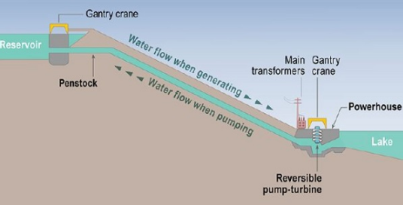
Figure 2: Example picture of PSH
According to DUKES (2016), the total electrical generation from hydro in 2015 for the UK was 6.3 TWh. 7.5% of the renewable generation was from large scale hydro.

Figure 3: UK coverage of hydro projects (RenewableMap, 2016)
PSH is one of the few large scale renewable sources which gives an affordable means for storing while generating low cost electricity carbon-free. It has the ability to generate electricity based on demand instantaneously.
23 GW of PSH capacity is undergoing construction with 8.3 GW announced for the future in the UK. (Scottish Renewables ,2016)
In the US there are currently 40 PHS plants in operations totalling a capacity of 22 GW which accounts for 95% of all the energy storage in the country. 50 more PSH projects have been proposed which could increase the total capacity by 40 GW. (U.S Department of Energy, 2015)
Global Energy Storage
Different storage systems have been used in other countries like pumped hydro energy storage (PHES), thermal, battery, and hydrogen storage. Pumped storage has been found to be the leader due to its high capacity, flexibility, and availability. (Al Zohbi, et al., 2015)
Scottish Renewables (2016) shows that 97% of world storage capacity is from PSH.
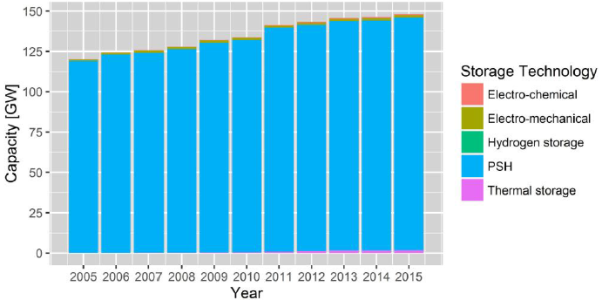
Figure 4: Installed global capacity of energy storage (Scottish Renewables, 2016)
Wind and Pumped Storage Combination
The are several other methods of which can be combined with wind energy (e.g. hydro, conventional thermal, gas). Pumped storage has the advantage of always having available power even during dry period. (Montero & Pérez, 2009)
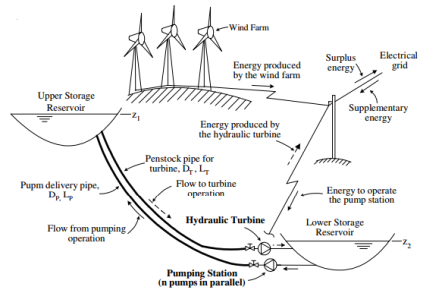
Figure 5: Hybrid wind and pumped storage plant (Anagnostopoulos & Papantonis, 2007)
Example 1
According to Ingram (2016), Germany are currently undergoing a pilot project for wind and pumped storage hydro. There will be four wind turbines installed and a 16 MW pumped storage unit on the Kocher river. This will give a fast response to the grid and reduce costs of electricity for the consumer. The 4 wind turbines will be commissioned by the end of 2017 and the PSH plant will be operational by 2018.
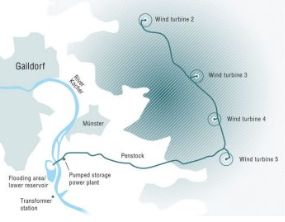
Figure 6: Pilot project combining wind and pumped storage hydro in Gaildorf, Germany (Ingram, 2016)
Example 2
A pumped storage system composed of 4 turbines and a 11MW wind farm has been built in one of the Canary Islands which will meet 80% of electrical demand. (Al Zohbi, et al., 2015)

Figure 7: Pumped Storage Plant (Montero & Pérez, 2009)
Example 3
The concept of a 10MW wind farm installed in the Faroe Islands combined with a pumped storage plant. The reservoirs will be connected at Miovatn (upper reservoir) and Vatnsnes (lower reservoir) which could give a capacity of 10MW. The cost of the storage plant is estimated to be 5.7 NOK/kWh. (Nordon Energy Research, 2013)
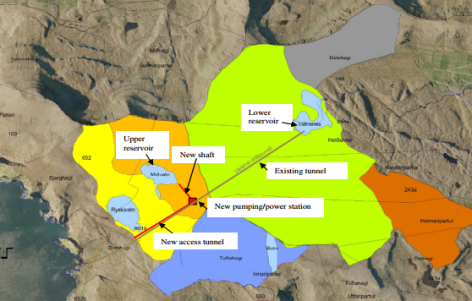
Figure 8: Catchment area in the Faroe Islands. (Nordon Energy Research, 2013)
IRENA (2015) shows an increase in both Wind and Pumped Hydro capacity by 2030 compared to 2013:

Figure 9: Total installed renewable capacity between year 2013 and 2030. (IRENA, 2014)
A disadvantage with PSH is it is very capital intensive with long development and construction times. The main contributors being the infrastructure of the hydro plant and second to this is the electro-mechanical equipment. According to IRENA (2012), the total installed cost ranges from $1000 – $3500/kW. This may also increase by an additional $3500/kW due to the cost of connecting to existing transmission networks; this depends from location to location.
Energy Interconnectedness
An electrical system which can become more flexible could save the UK consumers billions per year. Flexibility can come from interconnection of other electrical systems, for example wind and pumped storage hydro (PSH).
The European Commission has set a target of 10% electricity interconnection for 2020. They are building towards a more ‘integrated, competitive and sustainable common energy market’. They have put forward a European Energy Programme for Recovery (EEPR) mainly because of the economic crisis and with this have identified interconnection projects across the EU and to date spent 650 million EUR. (EuropeanCommission, 2015)
The UK currently has an interconnector capacity of 4GW with France, Netherlands, Northern Ireland, and the Republic of Ireland. (Ofgem, 2016) According to Becker (2015), there is a further 7.3 GW proposed interconnector capacity from for example Belgium, Denmark, and Norway.
The German Advisory Council requires 42 GW transmission capacity between Norway and Germany by 2050 to make PSH able to balance renewable electrical generation in Germany. Germany has a goal of 80% renewable electricity by 2050. (Ingebretsen & Johansen, 2014).
Norway possesses ~50% of the reservoir capacity in Europe. Norway provides 98% of its electricity from hydroelectric plants. Stone (2015) says that Norway could be a potential ‘Green Battery’ for the EU but is restricted due to political and social issues. However, it has been announced that a 1.4 MW 740 km link will join UK and Norway costing $1.64 billion which will be operational in 2021.
The Global Energy Interconnection Development and Co-operation Organization (GEIDO) is a Chinese group with a goal of an Asian super grid by 2050. There are now agreements between energy companies in China, Russia, Japan, and South Korea. They have highlighted geopolitics as a main obstacle for grid interconnected stability and assumed that there will be access to the newly developing ultra-high voltage lines which operates at 1000kV AC and 800 kV DC over 1000kms. (New Atlas, 2016)
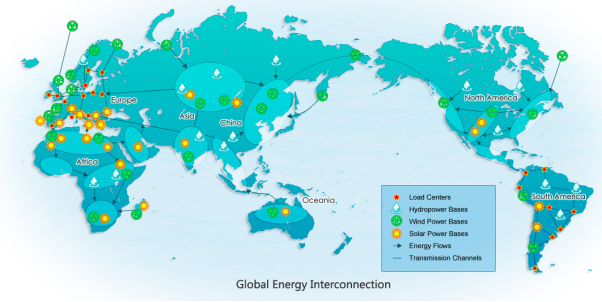
Figure 10: Global Energy Interconnection (GEIDO, 2016)
A disadvantage of interconnectedness between countries is shown in Andrews (2015). During the summer time our demand is assured however during winter time when electricity demand is at its highest there is a potential for other countries to take the supply leaving another without electricity (such as brownouts, blackouts, and overloads).
Conclusions
Wind and PSH will prove to be a necessity for providing energy security in the future. Wind is given an added benefit when combined with PSH of increased electricity usage by transferring energy at times of low demand. PSH is a mature and proven technology and gives the ability of supplying electric on demand within minutes.
The future of energy security also relies on the interconnectedness of nearby countries; connecting to Norway is seen as the most beneficially for supply of renewable electricity in the EU. However, on a global scale the geopolitical and social aspects between countries could be deemed as problematic and will need to develop if interconnector capacity between countries is to prosper.
Appendix
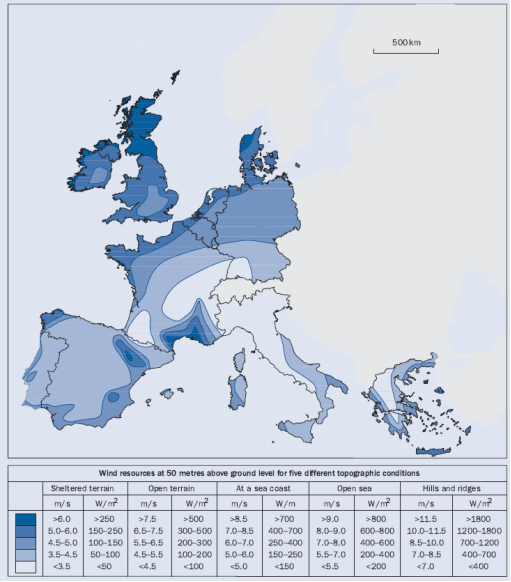
Figure 11: European Wind Atlas, onshore (EWEA, 2009)

Table 1: Technical wind energy potential in the EU (Dursun & Alboyaci, 2010)

Table 2: Worldwide hydroelectric storage potentials (Dursun & Alboyaci, 2010)
[1600 words]
References
AL ZOHBI, G. et al. (2015) Wind-hydro pumped storage systems to meet Lebanese electricity demand. Revue des Energies Renouvelables. [Online] 18. (September). p.375-397. Available from: http://www.cder.dz/download/Art18-3_3.pdf [Accessed: 19th December 2016]
ANAGNOSTOPOULOS, J. S. & PAPANTONIS, D. E. (2007) Pumping station design for a pumped-storage wind-hydro power plant. Energy Conversion and Management. [Online] 48. (August). p.3009-3017. Available from: http://ac.els-cdn.com/S0196890407002063/1-s2.0-S0196890407002063-main.pdf?_tid=9e097eee-c637-11e6-a2e7-00000aacb35f&acdnat=1482185465_9948b3b6017d5ca57015e6a48dc377ff [Accessed: 19th December 2016]
ANDREWS, R. (2015) UK Electricity Interconnectors – a Double-Edged Sword. [Online] Available from: http://euanmearns.com/uk-electricity-interconnectors-a-double-edged-sword/ [Accessed: 22nd December 2016]
BECKER, S. (2015) The role of interconnectors in GB adequacy planning. [Online] Available from: https://www.iea.org/media/workshops/2015/esapworkshopvi/Becker.pdf [Accessed: 21st December 2016]
COLEY, D. (2008) Energy and Climate Change: Creating a sustainable future. Chichester, United Kingdom: Wiley-Blackwell (an imprint of John Wiley & Sons Ltd).
DECC (2013) UK Renewable Energy Roadmap. [Online] Available from: https://www.gov.uk/government/uploads/system/uploads/attachment_data/file/255182/UK_Renewable_Energy_Roadmap_-_5_November_-_FINAL_DOCUMENT_FOR_PUBLICATIO___.pdf [Accessed: 19th December 2016]
DECC (2016a) 2010 to 2015 government policy: UK energy security. [Online] Available from: https://www.gov.uk/government/publications/2010-to-2015-government-policy-uk-energy-security/2010-to-2015-government-policy-uk-energy-security [Accessed: 22nd December 2016]
DUKES (2016b) Chapter 6: Renewable Sources of Energy. [Online] Available from: https://www.gov.uk/government/uploads/system/uploads/attachment_data/file/547977/Chapter_6_web.pdf [Accessed: 21st December 2016]
DURSUN, B. & ALBOYACI, B. (2010) The contribution of wind-hydro pumped storage systems in meeting Turkey’s electric energy demand. Renewable and Sustainable Energy Reviews. [Online] 14. (March). p.1979-1988. Available from: http://ac.els-cdn.com/S1364032110000924/1-s2.0-S1364032110000924-main.pdf?_tid=5ec049be-c639-11e6-aed4-00000aab0f27&acdnat=1482186218_81556fe3a59c4150108d199e7b2bc998 [Accessed: 19th December 2016]
EUROPEANCOMMISSION (2015) Energy Union Package: Communication from the Commission to the European Parliament and the Council. [Online] Available from: http://eur-lex.europa.eu/resource.html?uri=cellar:a5bfdc21-bdd7-11e4-bbe1-01aa75ed71a1.0003.01/DOC_1&format=PDF [Accessed: 21st December 2016]
EWEA (2009) Wind Energy – The Facts: A guide to the technology, economics and future of wind power. London, UK: Earthscan.
GEIDO (2016) Home: Global Energy Interconnection. [Online] Available from: http://www.geidco.org/html/qqnycoen/index.html [Accessed: 22nd December 2016]
INGEBRETSEN E. & JOHANSEN, T. H. G. (2014) The Profitability of Pumped Hydro Storage in Norway. Master of Science in Energy, Natural Resources and the Environment. Bergen: Norwegian School of Economics
INGRAM, E. (2016) Pilot Project Combining Wind and Pumped Storage Hydro Under Construction in Germany. [Online] Available from: http://www.renewableenergyworld.com/articles/2016/10/pilot-project-combining-wind-and-pumped-storage-hydro-under-construction-in-germany.html [Accessed: 19th December 2016]
IRENA (2012) Renewable Energy Technologies: Cost Analysis Series. [Online] Available from: http://www.irena.org/documentdownloads/publications/re_technologies_cost_analysis-hydropower.pdf [Accessed: 22nd December 2016]
IRENA (2015) Renewable Power Generation Costs in 2014. [Online] Available from: https://www.irena.org/DocumentDownloads/Publications/IRENA_RE_Power_Costs_2014_report.pdf [Accessed: 22nd December 2016]
MONTERO, F. P. & PÉREZ, J. (2009) Wind-Hydro Integration: Pumped Storage to Support Wind. [Online] Available from: http://www.hydroworld.com/articles/print/volume-17/issue-3/Articles/wind-hydro-integration-pumped-storage-to-support-wind.html [Accessed: 19th December 2016]
NEW ATLAS (2016) “Super Grid” the first step towards a global, interconnected, renewable energy grid. [Online] Available from: http://www.hotandbotheredinthekoots.org/single-post/2016/11/15/%E2%80%9CSuper-Grid%E2%80%9D-the-first-step-towards-a-global-interconnected-renewable-energy-grid [Accessed: 22nd December 2016]
NORDON ENERGY RESEARCH (2013) Wind power based pumped storage. [Online] Available from: http://www.nordicenergy.org/wp-content/uploads/2013/11/Wind-Power-Based-Pumped-Storage_Pre-Feasibility-Study_Suduroy-Faroe-Islands_2013.pdf [Accessed: 22nd December 2016]
OFGEM (2016) Electricity Interconnectors. [Online] Available from: https://www.ofgem.gov.uk/electricity/transmission-networks/electricity-interconnectors [Accessed: 21st December 2016]
OWENS, M. (2013) Is “pumped storage hydro power” the answer to storing wind and solar? [Online] Available from: http://www.fairfaxclimatewatch.com/blog/2013/07/is-pumped-storage-hydro-power-the-answer-to-storing-wind-and-solar.html [Accessed: 22nd December 2016]
RENEWABLEMAP (2016) Interactive Map of Renewable and Alternative Energy Projects in the UK. [Online] Available from: http://www.renewables-map.co.uk/renewable%20energy.asp?Status=1 [Accessed: 21st December 2016]
Scottish Renewables (2016) The Benefits of Pumped Storage Hydro to the UK. [Online] Available from: http://scottishrenewables.com/publications/benefits-pumped-storage-hydro-uk/ [Accessed: 19th December 2016]
STONE, M. (2015) Norway Could Provide 20,000MW of Energy Storage to Europe. [Online] Available from: https://www.greentechmedia.com/articles/read/Norway-Could-Provide-20000-MW-of-Energy-Storage-to-Europe [Accessed: 22nd December 2016]
U.S. DEPARTMENT OF ENERGY (2015) Pumped Storage and Potential Hydropower from Conduits. [Online] Available from: https://energy.gov/sites/prod/files/2015/06/f22/pumped-storage-potential-hydropower-from-conduits-final.pdf [Accessed: 22nd December 2016]
VARKANI, A. K., DARAEEPOUR, A. & MONSEF, H. (2011) A new self-scheduling strategy for integrated operation of wind and pumped-storage power plants in power markets. Applied Energy. [Online] 88. (July). p.5002-5012. Available from: http://ac.els-cdn.com/S0306261911004326/1-s2.0-S0306261911004326-main.pdf?_tid=133d350e-c636-11e6-ae64-00000aacb35d&acdnat=1482184803_c9d2b7c9ed21b898c1d50d549eded1f1 [Accessed: 19th December 2016]
Cite This Work
To export a reference to this article please select a referencing stye below:
Related Services
View allDMCA / Removal Request
If you are the original writer of this essay and no longer wish to have your work published on UKEssays.com then please click the following link to email our support team:
Request essay removal



